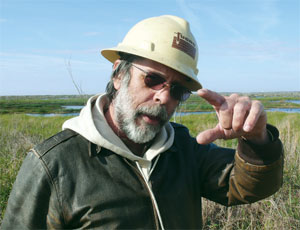Although Marie Laveau no longer practices voodoo in New Orleans, another “dark art” —soils testing—is practiced there, under unprecedented scrutiny and at a higher level of intensity than ever before.
“The work here is moving state of practice into state of the art,” says Dr. Rai Mehdiratta, program director for FFEB Geotechnical Consultants, a joint venture. He says the joint venture in the last two years has accomplished work that previously would have taken 15, “using more tools” in the process. “What we are doing here today, people will expect in the future,” he says.
The joint venture—Fugro Consultants Inc., Houston; Stantec Inc., Edmonton, Alberta, Canada; Eustis Engineering Co. Inc., New Orleans; and Burns Cooley Dennis Inc., Ridgeland, Miss.—has a $100-million contract to evaluate 350 miles of federal levees, provide 51,000 ft. of drilling and test 1.2-million lb of soil. That represents about 75% of the geotechnical work needed for $14.3 billion worth of work now going into the Greater New Orleans Hurricane and Storm Damage Risk Reduction System. To date, the joint venture has taken 2,584 undisturbed, five-in.-dia. borings, 1,397 cone penetrometer test soundings and 246 GeoProbes.
Extracting samples is not magic, but field operators need up to five years training, says Dennis Stauffer, Fugro’s technical coordinator for field operations. “Pushing something in the soil is the easy part,” says Stauffer, who has been doing such work for 28 years. “The hard part is knowing the soils, knowing when you have good data and when you have a problem. A good operator has an electrical and mechanical background and understands the soils.”
FFEB set up a local lab that director Byron Porter claims has the largest, most impressive array of soils-testing equipment in the country. “We do as many as 300 unconsolidated, undrained, triaxial tests a day,” Porter says.
In addition to undisturbed borings and CPTs, FFEB is doing a lot of vane shear testing, a tool commonly used in Holland but not much used before now in the U.S., Mehdiratta says. CPTs give readings of tip resistance and side friction, but with VST, the probe slowly turns while being pushed in, defining shear characteristics of the soil in situ, he explains. “When you are trying to define the properties of the soil, you want to have different methods of collecting information and more data,” Mehdiratta says. “You get more reliability that way. In Holland, they hardly drill borings, but here, people weren’t too familiar with CPTs and VSTs.”
The 2-in.-dia. CPTs and VSTs are also less invasive than 5-in.-dia. borings and create less waste, Mehdiratta says. “Instead of 500 borings, we can maybe do 200 CPTs and 300 borings and can map the way we do it.”
“The standard of practice before Katrina, before this project, was different—not just in New Orleans, but everywhere,” Porter says. “Our operation well exceeds ASTM requirements. Because of the scrutiny of the projects, the Corps wants everyone to exceed the standards.”


Post a comment to this article
Report Abusive Comment